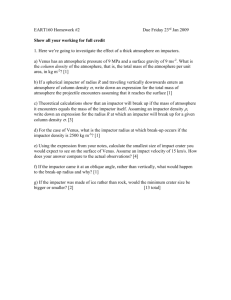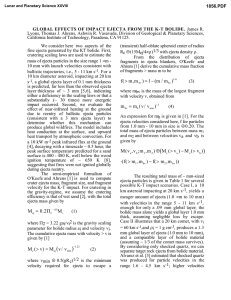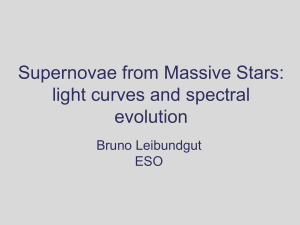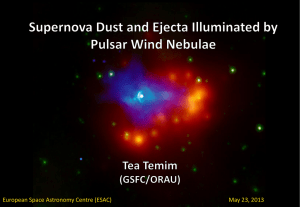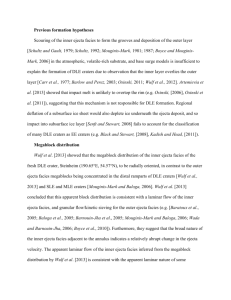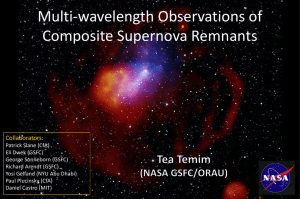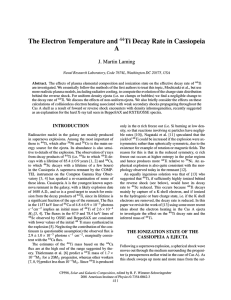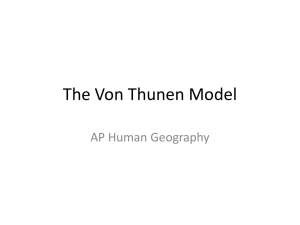87a-Ringberg12-pub
advertisement
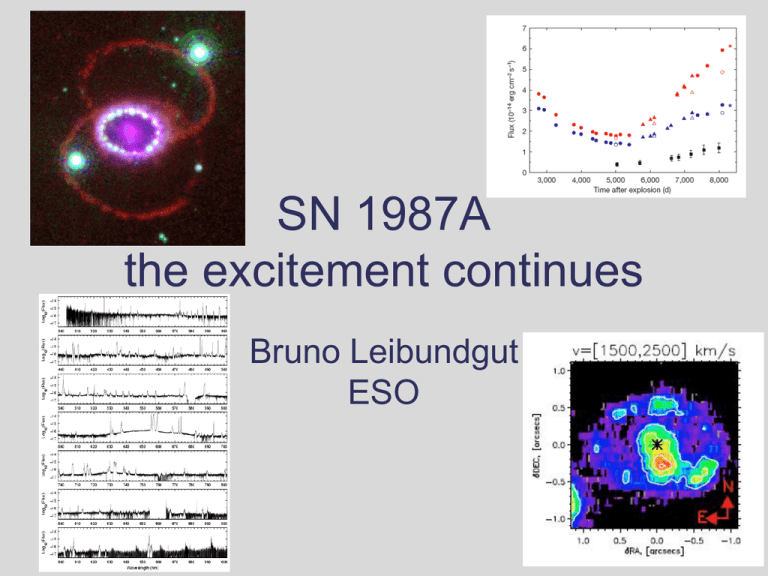
SN 1987A the excitement continues Bruno Leibundgut ESO SN 1987A – a great collaboration • Monitoring over the past two and a half decades Claes Fransson (Stockholm) Bob Kirshner (CfA) SINS and SAINTS (HST) Jason Spyromilio (ESO) Karina Kjær (Augsburg), Per Grőningsson (Stockholm), Anders Jerkstrand (Stockholm) The exciting SN 1987A today (9167 days since explosion) Fluorescing rings Shocks outer ejecta reached the inner ring Radioactively heated material inner ejecta Dust in and around the supernova Exciting developments 2011/12 • Detections by Spitzer and Herschel • Detection at mm wavelengths Lakićević et al. 2012 • Start to resolve0.87mm the- APEX radio image 3mm 3cm (contours) Lakićević et al. 2011 Lakićević et al. 2012 Matsuura et al. 2011 Dust - where is it? • Herschel fluxes indicate cold dust (~20K) Lakićević et al. 2012 Matsuura et al. 2011 – ~0.5 M dust in the ejecta • strongly depends on the temperature • location in the ejecta not completely obvious • IR/radio SED – dust – black body emission – synchrotron emission Optical, X-rays and Radio Park et al Manchester et al SN 1987A is brightening at all wavelengths Larsson et al. 2011 Zanardo et al. 2010 The complex SN 1987A @ 25 years Combination of several emission sites – inner ejecta – shocked ejecta – shocked inner ring – ionised inner ring – outer rings – light echoes Courtesy P. Challis, CfA The different emission sites in SN 1987A • SN ejecta – radioactively heated material (‘inner ejecta’) – X-ray heated ejecta – dust? • Rings – density enhancements in equatorial (?) plane – shock physics • forward shock (into the ring) The ring collision Dominating at all wavelengths shock emission increasing for the past 10 years Emission from the stationary ring narrow lines (FWHM ≈ 10 km/s) known since 1987 - fading Shocked ring region (forward shock) intermediate lines (~300 km/s) Reverse shock ejecta (~15000 km/s) New phase in the Xrays? • Turnover of the soft X-rays • signature of decreasing density structure? Park et al. 2011 Emission line components • SN 1987A in Dec 2010 – Xshooter The emission line components 4 Flux 3 Hα 2002 2000 2 1 0 -20000 -15000 -10000 -5000 0 5000 10000 15000 20000 velocity (km/s) Michael et al. HST/STIS 1999 Reverse shock Forward shock is ionizing the ejecta At some point all H atoms will be ionized before they reach the reverse shock and the emission will turn off X-rays give the amount of ionizing photons Monitoring the Hα emission will tell Smith et al. 2005 Hydrogen in SN 1987A • ‘Clean H’ • Flux increase by ~3.5 from 2000 to 2009 • vmax>11000 km/s Day 7998 larger than possible in equatorial ring anisotropic expansion • ejecta brightened • asymmetry indicates dust Fransson et al. 2012 Spatially resolved infrared spectroscopy separate ring from ejecta trace the ring in individual lines get spectra from separate regions photometry of selected regions Ejecta resolved Ground-based near-IR data show spatially resolved ejecta Kjær et al. 2010 Asymmetry in the ejecta [Si I] +[Fe II] [Si I] +[Fe II] 1.64 μm Ejecta kinematics Southern part is redshifted, northern ejecta are blueshifted Expansion velocity roughly 3000 to 4000 km/s This is the same orientation as the inner ring! Ejecta lies in the same plane as the ring! The inner ejecta • Comparison optical vs. IR – optical • heated by X-rays – IR • radioactive heating Summary SN 1987A is as interesting as ever ring collision is in full swing forward shocks in/past(?) the ring reverse shock in the debris (outer ejecta) heating of the inner ejecta first direct look at the inner parts of an explosion resolved inner ejecta are the immediate result of the explosion mechanism confirmation of the standing accretion shock instability (SASI) neutrino convection in the explosion More to come • Complete destruction of the ring • Disappearance of the reverse shock • Illuminating the outside – beyond the inner ring • Detailed mapping of the inner ejecta – details on explosion mechanics and distribution of synthesized material – dust formation • ALMA! • Where is the neutron star?
